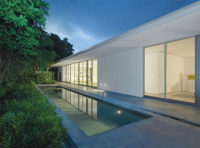Nishinomiya, Japan
Conceptually, the quirky house on an L-shaped lot in the affluent outskirts of Osaka has a lot in common with a traditional Japanese dwelling. Fixed, internal walls are conspicuously absent, furnishings delineate functional zones, and the roof is the defining architectural element. It even has a hanare, or freestanding room separated from the main house. But any likeness between old and new comes to a screeching halt there. Called House K after the first letter of the client's last name, the latest home from Sou Fujimoto'a Tokyo architect known to push residential design to extremes'is a single, swooping volume that emerges gently from the ground and then rapidly surges upward before tapering to a blunt point at the site's east end. Studded with trees in giant steel planters, the sloped wedge of a house looks more like a man-made landform than a place to call home.
While the notion of blending architecture and landscape fascinates Fujimoto, it wasn't exactly what his clients, a couple with two school-age kids, initially had in mind. Though they had few specific requests, their first hope was to create a facsimile of Fujimoto's House N (which appeared in the April 2009 issue). But try as he might, the architect could not fit that building's nesting-box scheme on the 3,340-square-foot property, hemmed in by houses on three sides, open to a grove of trees on the fourth, and tethered to the street by a 98-foot-long path.
These constraints inspired Fujimoto to design the hill-like scheme with a folded roof, softly creased like origami paper to form two angled surfaces. As it ascends from the grove, the west-facing plane inclines from 10 degrees to 35 degrees along its length. The result is a striking exterior and spacious interior. Acting as both wall and roof, the north-facing elevation rises abruptly from the ground at 45 degrees but nears 53 degrees toward the top. Tilted sharply away from the house to the north, this angled surface yields much-needed breathing room from neighboring houses and creates a logical place for the glass-encased entrance foyer.
The house sits 18 feet above the end of a 10-foot-wide lane and is accessed by two flights of stairs. Protected by a canopy, the main entrance opens onto a vestibule with a tile floor that segues into the dining area and kitchen'a kind of command center with unimpeded sightlines in multiple directions. As with all Fujimoto-designed dwellings, House K contains a sequence of spaces with ambiguous borders and many possible functions. Where the ceiling rises, broad steps that double as auxiliary seating lead up to a loftlike sleeping area used by the parents. Tucked beneath are the bathroom and children's bedroom'the only spaces with bona fide walls and doors. On the opposite side of the house, a stair leads to a sunken living area beneath the descending ceiling. The hanare, perched at the roof's lowest part, provides a private getaway, with a sitting area and powder room.
An antidote to the communal lifestyle prescribed by Fujimoto's architecture, the hanare also establishes visual balance. 'If the roof was completely naked, it would be too strong,' the architect explains. 'And from the start I wanted to make it a field for activity.' The roof garden supplies the clients with precious outdoor space where the kids can play and the family can enjoy ice cream on hot summer evenings.
Not surprisingly, the roof was the most difficult part of the house to construct. To keep costs down, Fujimoto opted for a steel-frame system made of 4-by-4-inch H-beams spaced 3 feet apart. Joined with rigid welded or bolted connections, the frames are linked by connecting beams at the roof's edges. They support a 3-inch-thick concrete skin that was applied by hand and then finished with waterproofing and paint. Inside, painted plasterboard walls and ceiling contrast softly with white-tinted birch floors. Custom furniture and the potted trees, anchored to the structure, dot the roofscape, along with six large skylights'two of them operable, enabling indoor-outdoor circulation via ladders from the sunken living room and loft stairs.
With its curving trajectory, House K marks a dynamic new direction for Fujimoto. Not everyone would feel at home with its unusual geometry, especially where safety is concerned. While the loft's broad stairs and the low railings rimming the living area were configured to prevent falls, the roof is devoid of parapets and guardrails. The trade-off for watching one's step, however, is a chance to live in a place that expands the very notion of what a home and garden can be, elevating it to new heights and possibilities.
Completion Date: July 2012
Size: 1,275 square feet
Total construction cost: withheld
Architect:
Sou Fujimoto Architects
PeopleOwner: withheld
Architect
Personnel in architect's firm who should receive special credit: Project team: Yoshihiro Nakazono, Naganobu Matsumura, Ryota Okada, Naoki Tamura
Consultant(s): Landscape: Furukawateijuen : Motokazu Furukawa Lighting: Sirius Lighting Office: Hiroto Totsune, Shuhei Kobayashi, Yuya Tanaka General contractor: Tokuoka Koumuten Co.,Ltd. Photographer(s): Iwan Baan |
Products
Structural system
Glazing
Lighting
|










Post a comment to this article
Report Abusive Comment